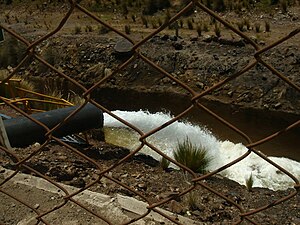Sewage treatment
Sewage treatment is the process of removing contaminants from waste water and household sewage, both runoff (effluents), domestic, commercial and institutional. It includes physical, chemical, and biological processes to remove physical, chemical and biological contaminants. Its objective is to produce an environmentally safe fluid waste stream (or treated effluent) and a solid waste (or treated sludge) suitable for disposal or reuse (usually as farm fertilizer). Using advanced technology it is now possible to re-use sewage effluent for drinking water.
Sewage disposal
Industrial wastewater effluent with neutralized pH from tailing runoff. Taken in Peru.
In some urban areas, sewage is carried separately in sanitary sewers and runoff from streets is carried in storm drains. Access to either of these is typically through a manhole. During high precipitation periods a sanitary sewer overflow can occur, forcing untreated sewage to flow back into the environment. This can pose a serious threat to public health and the surrounding environment.
Sewage may drain directly into major watersheds with minimal or no treatment. When untreated, sewage can have serious impacts on the quality of an environment and on the health of people. Pathogens can cause a variety of illnesses. Some chemicals pose risks even at very low concentrations and can remain a threat for long periods of time because of bio accumulation in animal or human tissue.
Treatment
Further information: Sewage treatment, Agricultural wastewater treatment, and Industrial wastewater treatment
There are numerous processes that can be used to clean up wastewaters depending on the type and extent of contamination. There are two basic approaches: to use the waste in the water as a resource (such as constructed wetlands) or strictly as a pollution (such as the majority of today's treatment plants). Most waste water is treated in industrial-scale energy intensive waste water treatment plants (WWTPs) which include physical, chemical and biological treatment processes. However, the use of septic tanks and other On-Site Sewage Facilities (OSSF) is widespread in rural areas, serving up to 20 percent of the homes in the U.S.
The most important aerobic treatment system is the activated sludge process, based on the maintenance and re circulation of a complex biomass composed by micro-organisms able to absorb and adsorb the organic matter carried in the waste water. Anaerobic waste water treatment processes (UASB, EGSB) are also widely applied in the treatment of industrial waste waters and biological sludge. Some waste water may be highly treated and reused as reclaimed water. Increasingly, for most waste waters ecological approaches using reed bed systems such as constructed wetlands are being used. Tertiary treatment is being increasingly applied and most common technologies are micro filtration or synthetic membranes. After membrane filtration, the treated wastewater is indistinguishable from waters of natural origin of drinking quality (without its minerals). Nitrates can be removed from waste water by natural processes in wetlands but also via intensive microbial denitrification, for which a small amount of methanol is typically added to provide the bacteria with a source of carbon. Ozone waste water treatment is also growing in popularity, and requires the use of an ozone generator, which decontaminates the water as ozone bubbles percolate through the tank but is energy intensive.
Disposal of waste waters from an industrial plant is a difficult and costly problem. Most petroleum refineries, chemical and petrochemical plants have onsite facilities to treat their waste waters so that the pollutant concentrations in the treated waste water comply with the local and/or national regulations regarding disposal of waste waters into community treatment plants or into rivers, lakes or oceans. Constructed wetlands are being used in an increasing number of cases as they provided high quality and productive on-site treatment. Other industrial processes that produce a lot of waste-waters such as paper and pulp production has created environmental concern, leading to development of processes to recycle water use within plants before they have to be cleaned and disposed.
Reuse
Treated wastewater can be reused as drinking water, in industry (cooling towers), in artificial recharge of aquifers, in agriculture (70 percent of Israel's irrigated agriculture is based on highly purified wastewater) and in the rehabilitation of natural ecosystems.
Use of untreated wastewater by agriculture
Around 90% of wastewater produced globally remains untreated, causing widespread water pollution, especially in low-income countries. Increasingly, agriculture is using untreated wastewater for irrigation. Cities provide lucrative markets for fresh produce, so are attractive to farmers. However, because agriculture has to compete for increasingly scarce water resources with industry and municipal users, there is often no alternative for farmers but to use water polluted with urban waste directly to water their crops.
Health hazards of polluted irrigation water
There can be significant health hazards related to using the water in this way. Wastewater from cities can contain a mixture of chemical and biological pollutants. In low-income countries, there are often high levels of pathogens from excreta, while in emerging nations, where industrial development is outpacing environmental regulation, there are increasing risks from inorganic and organic chemicals. The World Health Organization, in collaboration with the Food and Agriculture Organization of the United Nations (FAO) and the United Nations Environmental Program (UNEP), has developed guidelines for safe use of wastewater.
The International Water Management Institute has worked in India, Pakistan, Vietnam, Ghana, Ethiopia, Mexico and other countries on various projects aimed at assessing and reducing risks of wastewater irrigation. They advocate a ‘multiple-barrier’ approach to wastewater use, where farmers are encouraged to adopt various risk-reducing behaviours. These include ceasing irrigation a few days before harvesting to allow pathogens to die off in the sunlight, applying water carefully so it does not contaminate leaves likely to be eaten raw, cleaning vegetables with disinfectant or allowing fecal sludge used in farming to dry before being used as a human manure.



No comments:
Post a Comment